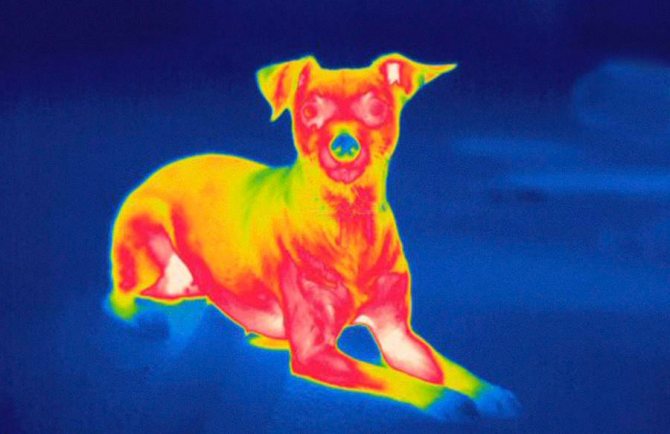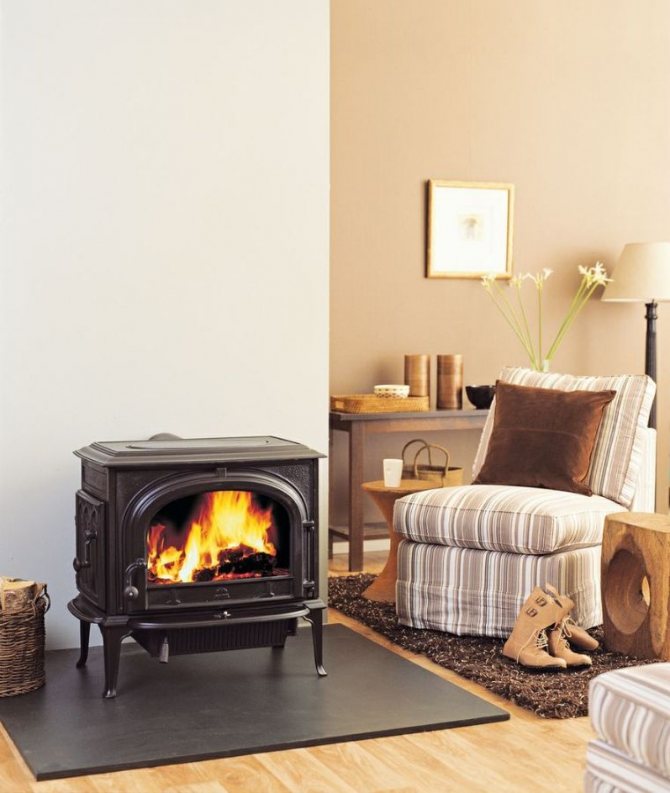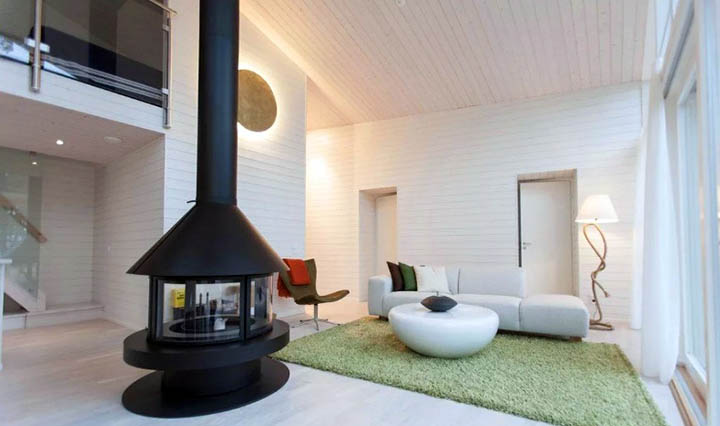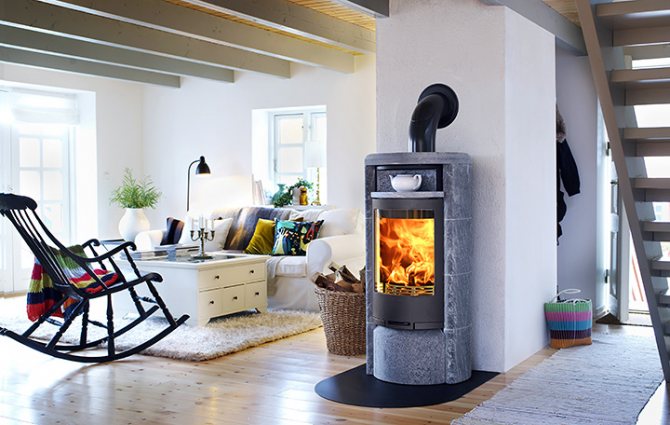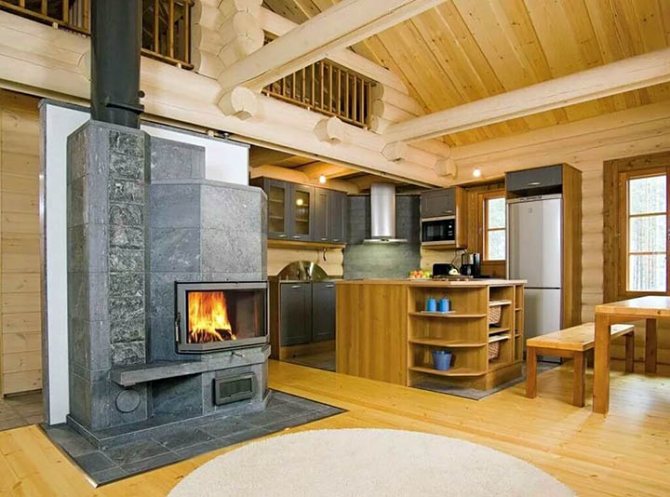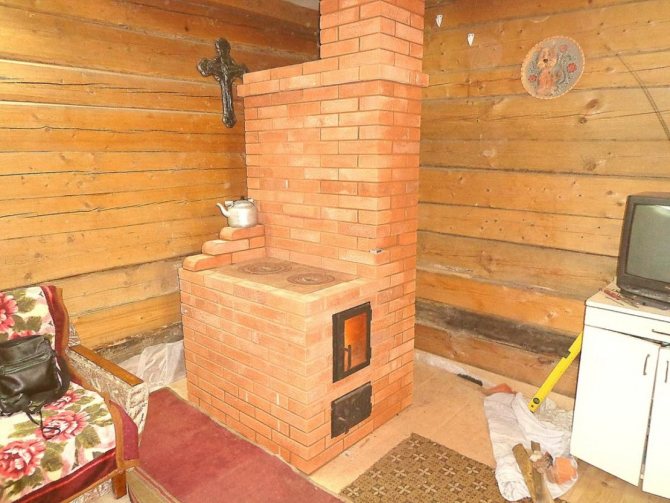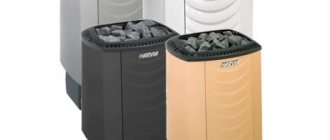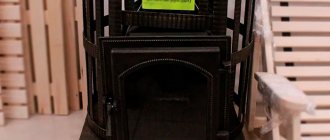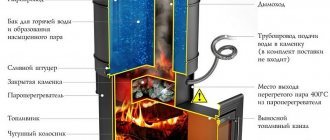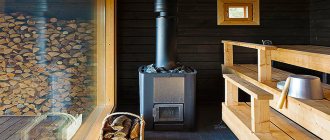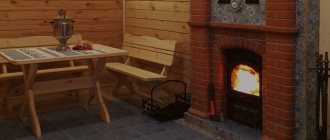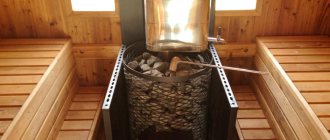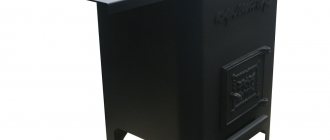How to count for a Russian bath
The power of the stove for heating the bath is calculated based on the dimensions and parameters of the steam room. After all, the main task is to create the required temperature for this particular room. It is calculated by cubic capacity, but when calculating, it is still necessary to take into account several additional factors at once, to summarize the figures obtained. As a result, we obtain the required furnace performance for this type of steam room.
It has long been established that, on average, a heat output of 1 kW is required to heat one cubic meter of a steam room. Therefore, first, you need to know the length * width * height of the steam room. Multiplying these values in meters, you get the volume of the room, and, therefore, the minimum performance of the heating unit.
For example, a steam room has dimensions of 3 m * 2.8 m * 2.8 m. Multiplying, we get 23.5 cubic meters. In principle, when choosing, you can be guided by this figure ... But not everything is so simple. It is necessary to consider the following points:
- Is there a window in the steam room. If there is, you need to add 3 kW for each square meter of the window area (this is if the glazing is single), if the glazing is double, apply a reduction factor of 0.5. For example, there is a 50 * 40 cm window with one glass. It is necessary to add 0.5 m * 0.4 m * 3 kW = 0.48 kW.
- If there are brick walls in the steam room, 1 kW is added to each square (the high heat capacity of the brick requires additional heating).
- If there is a non-insulated door (wooden or glass), add about 10% more power reserve.
- Insulation degree. If everything is done according to the recommendations (insulation thickness), with a vapor barrier, the joints are glued with tape, no changes can be made. If the insulation is so-so, you can add 20-30% to the power already found.
- If the stove is fired from an adjacent room, it is also necessary to increase the required capacity by at least 10%.
In general, sometimes a pretty solid increase is obtained. But for a bath, it is better to have a stove with a higher power than a lower one: it is better to stifle the combustion than not be able to heat the steam room to the required temperature. The reserve is especially important for the baths of periodic visits. In winter, in a week, they freeze through and through. When putting them into vaping mode, reserves will come in handy, which in summer seem to be absolutely superfluous.
Another plus of the stove productivity margin is that there is no need to heat it up red. With such intense heating, the furnace usually burns out quickly. To prevent this from happening, a fairly decent supply is needed.
Another advantage of higher power sauna stoves can be considered a large laying of stones, which means more comfortable steaming conditions, longer maintenance of the temperature in the steam room. There are also disadvantages. This is the price and size. Both are not fatal, but unpleasant.
Sauna features
The principle of calculating the power of sauna stoves remains the same: they are calculated by the volume of the steam room, the degree of insulation of walls and windows / doors is taken into account. Just take into account that the steam room is ready with average insulation in 2-3 hours. To reduce the time by 1 hour, it is necessary to increase the power by 60-80% (or improve the heat-insulating properties). But steam rooms in saunas usually do less than in baths. People sit quietly in them, and do not wave brooms. So really, too much performance is not required.
If you look at the catalog of wood-burning stoves for baths and saunas, then they are divided according to the volume of the steam room. This is convenient when choosing (taking into account all corrections for heat loss). If you are going to buy an electric heater for a sauna, then only the power consumption is often written in the technical specifications.In this case, for periodical saunas without constant heating, you can navigate according to the norms:
- blockhouse (log or timber) without additional insulation - 1.4-1.8 kW / m3 with a wall thickness of 100-140 mm, 1.5 kW / m3 is required;
- with a wall thickness of 200-240 mm - 1.75 kW / m3;
There is no error in the given norms: with an increase in the thickness of log walls without insulation, an increase in power is required. This is due to the high heat capacity of wood. And the more wood there is, the more heat will be spent on heating it. If there is good thermal insulation inside the sauna, the power is calculated according to the standards of the frame.
In the presence of constant heating, other standards are used to calculate the required power of an electric stove for a sauna - an average of 0.7 kW / m3 is taken. This norm is true for saunas in an apartment. So, in this case, using electric heaters is not that expensive.
When planning energy costs, please note that electric sauna ovens operate at full power only for the period of "acceleration" of the steam room - until the required temperature is reached. Then they either manually turn off and periodically turn off (cheap models), or automatically maintain the set temperature. In any case, after reaching the set temperature, the power consumption is reduced.
baniwood.ru
The microclimate of the Russian bath has a characteristic temperature of 60-80 ° C and humidity in the range of 40-60%. The efficiency of a metal furnace is to maintain a microclimate that changes depending on: ● the degree of insulation of the steam room ● heat capacity of the walls and cladding ● the presence of windows, doors, uncovered masonry. At the same time, only that stove, which is selected taking into account the ratio of power to the multi-part area of the steam room, is able to quickly create (and maintain for a long time) the necessary temperature and humidity conditions.
Selection parameters
Since the kilowatts reproduced by the iron stove and the range of cubic meters heated by it are indicated in the list of technical characteristics of a particular model, the buyer can only determine the heated volume of the steam room and calculate the power required for this.
Why are taken into account: ● volume (Vpair) - the product of length, width and height of the room; ● heat loss for heating closed openings (Hdoors, Hwindows) and brick partition (Hwalls). On average, heating them 1 m2 consumes the same amount of heat as is required for heating 1.2 m3 of the internal volume of the room; ● absorption of thermal energy by the walls of the bath (k). Average coefficient for: ➢ non-insulated log cabin - 1.6. ➢ insulated wooden wall - 1 ➢ vapor barrier with foil that reflects infrared radiation - 0.6. According to the formula V = k * (Vpair + Hdoor + Hwindow + Hwall), the estimated volume is calculated, being guided by which you can choose a suitable furnace.
An example of the selection of a metal stove
Let's consider the calculations using the example of a steam room: 1. in a log house, 2. in a log house with external insulation, 3. with a vapor barrier under the inner lining, without emphasis on the main material of the walls. The initial data common to all options: the steam room has a size of 2 x 2 x 2 (m), has a window to the courtyard, a door to an adjacent room and a brick wall without insulation, through which the firebox of a metal stove will be brought into the adjacent room.
Actual room volume (Vpair)
The product of 2.5 m wide, 2 m long and 2 m high is 8 m3
Cubic equivalent of heat loss in areas without insulation
Applying the coefficient 1.2 to the area: ➢ windows 0.5 x 0.8 we get 0.48 m3 (H-windows); ➢ doors 0.8 x 1.8 - 1.7 m3 (H doors). ➢ brick wall 0.8 x 2 - 1.9 m3 (Hwall).
The estimated volume of the steam room and the required power of the stove
The rounded sum of the calculated values (14 m3) is considered the estimated volume of the steam room, only after applying a coefficient to it that takes into account the material of the walls.
r /> ✓ Ordinary log house (k = 1.6) - 22.4 m3 ✓ Insulated wooden wall (k = 1) - 14.0 m3 ✓ Vapor barrier under the cladding (k = 0.6) - 8.4 m3 Based on the fact that to warm up 1 m3 of a steam room for an hour, 0.7 kW of the power of a metal furnace will be required (respectively: 15.7 kW, 9.8 kW, 5.9 kW) - the choice can be made based on this characteristic in the passport of the device.
Equipment selection
Despite the same volume of the room, different wall materials require the use of different heating equipment. That is, for each of the three considered options for steam rooms, a certain model of the stove is required. Due to the fact that the manufacturer is constantly improving the model range, it would be more expedient to indicate only the basic models for the calculation results. ❖ For a steam room in a log house, taking into account the large heat losses, a device with a declared power of at least 15 kW / h is required for heating the estimated 22.4 m3. The Dobrostal furnace Empress Augusta STONE strong (14-16 kWh), designed to work in a room of 10-22 m3, meets these requirements. This model has rightfully taken the 1st place among the sauna stoves of the middle price class. ❖ A similar steam room, but already in a wooden frame insulated from the outside, is heated by equipment with a capacity of 9.8 kW / h.
it is more irrational to purchase 14 m3 for heating. Therefore, Malyutka 500U (9.8 kW / h), with a "working" range of 6-16 m3 is an acceptable option. ❖ The steam room, which has foil insulation under the casing, requires a stove with a capacity of 5.9 kW / h. The foil reflects infrared rays, the heat stays inside. The Extra 400U model, with a declared 6.8 kW / h for 4-12 m3, should be considered the most efficient metal stove under the established conditions. Other factors affecting the characteristics of the basic equipment: ● combustion box ● thickness of the walls of the furnace ● design of the door
They affect cost, service life and the level of comfort in service. Therefore, it should only be viewed with your own preference.
www.pban.ru
Posted by: vika_b 1 year, 10 months ago
Calculation of the power of the stove for a bath, depending on the volume of the steam room
The sauna stove should be chosen with the optimal power based on the volume of your steam room.
You cannot be mistaken in choosing the power of the sauna stove, because then there will be no good steam: neither in the case when the power is insufficient, nor in the case when the power of the stove is more than required.
If you put a small stove in the bath with insufficient power for a given volume of the steam room, then it will have to be operated beyond its capacity, which will lead to rapid wear and tear of the stove.
If you buy a stove with a margin for reasons that the power reserve is never superfluous, then yes, indeed, the bath will heat up quickly and hot! But in order to bathe in comfortable conditions, it will be necessary to artificially reduce its capabilities while vaping and ventilate the steam room after each call. As a result, balanced steam cannot be obtained due to the fact that the stones in the stove are not so hot. And, if you maintain the desired temperature of the stones (at least 500 degrees C), it will be too hot on the shelf and even in the lower zone, near the floor.
The calculation of the power of the oven for the bath must be done in the following sequence:
1.determine the volume of the steam room by multiplying its internal dimensions: width, length and height. For example, a steam room has dimensions of 3x2m and a height of 2.2m. This means that its volume is -13.2 m3.
2.Calculate the heat loss by cold surfaces such as a glass door, window, brickwork partitions by multiplying the area by a factor of 1.2, assuming that each square meter of such a surface absorbs the heat necessary to warm up 1.2m3. For example, in a steam room there is a window with dimensions of 0.5 * 1.0m = 0.5m2 and a glass door with dimensions of 1.8 * 0.8m = 1.44m2. This means that the heat loss will be (0.5m2 + 1.44m2) * 1.2 = 2.33m3
3. Summarize the calculated cubic capacity: the total volume of the steam room and the heat loss from cold surfaces.We add the previously calculated figures for items 1 and 2 and we get the volume required for heating, which in our example is (13.2 + 2.33) = 15.53m3
4. the correct calculation of the power of the stove for the bath is obtained if we take into account the material from which the bath is built, since the structures of the walls, ceiling and floor also absorb a decent amount of heat. For example, for a log bath, without finishing, you need to apply a coefficient equal to 1.6, and if the inside of the steam room is lined with clapboard, yes with foil, and with insulation, then a reduction coefficient is taken equal to 0.6 (since such a wall does not absorb, and repels heat from itself). So, for logs in a steam room, the design capacity of the furnace will be 15.53m3x1.6 = 24.85 m3 = 24.85 kW (from considerations that for 1 m3 of the calculated volume of the steam room, 1 kW of furnace power is sufficient).
5. When buying, we choose the oven with a power in the range of 25 kW
The data for calculating the power of the stove for each specific bath may differ in their characteristics due to the use of various materials and designs of the structure itself, or some additional factors, for example, the presence of forced ventilation, etc.
Since steam in a Russian bath is formed as a result of splashing water on hot stones, it is necessary when choosing a bath stove to look not only at its nominal power, but also at the volume (weight) of stones that can be placed in this stove.
Calculation of stones for the stove in the bath
Different sources recommend a different amount of stones per 1 m3 of a steam room with 15 people soaring at the same time for 5 hours.
snake at a minimum: 30kg. Therefore, for our example, you need 30kg * 24.85m3 = 745.5kg.If the steam room is calculated not for 15, but for 5 people, then, accordingly, you need to reduce the volume of stones by 3 times: 745.5 kg / 3 = 248.5 kg ... Something too much for a 25 kW stove and weighing no more than 200 kg (cast iron) .... And what size should a metal stove be to fit so many stones? In another "ancient" book, it is recommended for every 6 liters of water supplied - 8kg of cobblestone and 1.5kg - for 1 m3 of steam room volume. In an hour, 5 people pour no more than 4 liters of hot water onto the stones, so during 5 hours of continuous vaping, they will spend at least 20 liters (which is unlikely). Still, we will reduce the amount of water by 30%, taking into account the pauses for airing and rest. It turns out that you need only 18.7 kg. We will also calculate the number of stones for the bath, taking into account the volume of the steam room: 1.5 kg * 24.85 m3 = 37.5 kg. We add everything up and get: 37.5 kg + 18.7 kg = 53.2 kg of cobblestone. This is already an acceptable figure for an ordinary simple bath. You can make a more complex calculation of stones for a bath, determining the required amount of heat by evaporation and heating ... But .., the task of this article is to determine the required power of the stove for the bath. Therefore, let's estimate how many kW is needed to heat 53.2 kg of stones for 15 minutes (the approximate time allotted for a pause between soaring) to a temperature of 500 degrees:
1kg of stones from a temperature of 500 degrees, cooling down to 200 degrees (a difference of 350 degrees), will give 294 kJ (0.84 kJ / kg * C x 1 kg x 350C).
53.2 kg will give 294 kJ * 53.2 kg = 15640.8 kJ. How much heat will be given off during cooling, the same amount needs to be replenished.
1 kW = 3600 kJ / hour
We convert kJ to kW, we get 4.35 kW per hour
Recalculated for 15 minutes: 4.35 * 4 = 17.40 kW
Conclusion: a furnace power of 20 kW will provide heating up to 500 degrees 53.2 kg of stones every 15 minutes. Let's add another 5 kW to the calculation of the power of the bath furnace to take into account heat losses through structures and cold surfaces. So, for a steam room with dimensions of 3x2x2.2m, a 25kW oven is needed, based on two different calculations:
By the volume of the steam room and cold surfaces
By the number of stones
With a lower flow rate under the supplied water, for example, when steaming not five people, but two, for not five hours, but only a couple of three, you can choose a stove with a lower power (20 kW).
You can always buy from us both heating stoves and stoves for baths and saunas.
follow the link and buy
or order a call back
lefrat.ru
The presence of a high-quality bath is perceived by the majority of owners of country houses as a self-evident addition to the created comfort of their living space.When building a bathhouse "from scratch" or when re-equipping existing premises for it, the question of purchasing a stove-heater for a steam room will invariably arise. The range of these peculiar heating devices is currently extremely wide, and it is possible to choose a conventional wood-burning, gas or electric stove, depending on the specifics of the conditions available.
However, the stove should be chosen only by the type of fuel (energy carrier) used, appearance, dimensions, ease of use, although these criteria are extremely important. Even the most expensive and beautiful heater will become completely useless if it is not able to cope with its direct task - creating and maintaining the required temperature in the steam room, that is, that very specific bath microclimate. And you can make a mistake when choosing one way or the other. A low-power oven simply will not be able to "catch up with steam", and a device with too high heat output values is an unnecessary waste both when purchasing and during operation. How to be? A calculator for calculating the thermal power of a stove for a bath will help in solving this issue.
We recommend that the reader, before proceeding directly to the calculations, read the explanations given below the calculator itself.
Calculator for calculating the thermal power of a stove for a bath
The specifics of calculating the power of a bath stove
First of all, let's figure out the units of measurement.
Power, more precisely, the calorific value of a heating device is measured in kilowatts. It is believed that to ensure a healthy bath microclimate, it is necessary to spend about 1 kW for each cubic meter of steam room volume. However, it is undesirable to proceed only from such a ratio, since it is easy to make a mistake.
- The sauna stove has a special design - it is supposed to have a stone insert, external, which can be located on top, along the walls and / or along the initial section of the chimney, and sometimes also internal. Stones play a very important role in the heat output of a sauna stove, and their number must correspond to the parameters that are mandatory specified in the device's passport.
- In addition, in most cases, the power of the stove is also used to heat water - a hot water tank is hung (attached) to the stove, or the design of the device is equipped with a built-in heat exchanger
All this is said in order to correctly understand - the "pure" power indicator of the device sometimes does not show the real picture. If you familiarize yourself with the technical characteristics of bath stoves, one cannot fail to notice that the manufacturer usually indicates the range steam room volume, which is guaranteed to be warmed up by this model. Therefore, they try to choose the stove in such a way that the available parameters of the steam room fall approximately in the middle of this specified range. For example, you need a sauna heater of 14 m³. The optimal model will be a model with a passport range - from 10 to 18 m³.
It would seem that there is nothing simpler: multiply the length, width and height of the steam room - and here's the finished volume ... No, and this is not entirely true. The fact is that any steam room can also have its own characteristics, which sometimes make very significant adjustments to the required indicators of the thermal performance of the furnace. This is taken into account in the proposed calculator.
- So, first of all, the user is asked to enter the linear dimensions of the steam room - its length, width and height of the ceiling. The values are indicated in meters (with an accuracy of 0.1 m).
- In the steam room, they always try to perform the most effective thermal insulation, using various insulation materials for this, including those with a foil covering facing the room. And only then the surfaces are sheathed, as a rule, with a natural board or clapboard. No power adjustments in this regard are expected.However, when the bathhouse is made in a log cabin, or its walls are assembled from a bar, sometimes the inner cladding is simply neglected. This approach, of course, is understandable, but in this case it will be necessary to increase the power of the furnace, since a significant amount of heat will be spent on heating massive wooden parts with a very high heat capacity.
- The stove can be located completely in the steam room, but it is more convenient and safer to use devices in which the fuel window is placed in the dressing room. But this is already a "gap" in the overall thermal insulation of the room, which also requires an amendment to the calculation, since some of the heat will simply be lost, heating the air in the adjacent room.
- If the door to the steam room has internal insulation and is very well fitted to the opening, then significant heat loss through it is not expected. But they are often limited to a simple wooden panel board, and recently glass door leaves are also actively becoming fashionable. It is already necessary to make an amendment on this score.
- It will require adjusting the power indicators and the presence of a window in the steam room. Moreover, the magnitude of the correction will depend on the area of the window and on the type of its glazing. If this type of calculation is selected, additional fields for entering values will open in the calculator.
- And, finally, there are often sections of surfaces in the steam room (it does not matter if it is a floor or walls), faced with stone or ceramic tiles, fragments of brickwork. The heat capacity of these materials is very high, and they will "pull" a certain amount of thermal energy onto themselves. Therefore, this amendment is also included in the calculation.
- The final result will be issued, so to speak, in given the volume of the steam room, which includes its real dimensions, and all the necessary adjustments for the specifics of the room. It is on this value that one should be guided when choosing a stove.
Brick the sauna stove? - no problems!
Some sauna stoves have a very rich external finish, but simpler, cheaper models with an unprepossessing appearance can also fit into the interior of the steam room by making a brick "case" for them. How to brick a sauna stove yourself - read in a special publication of our portal.
stroyday.ru
Determination of heat loss at home
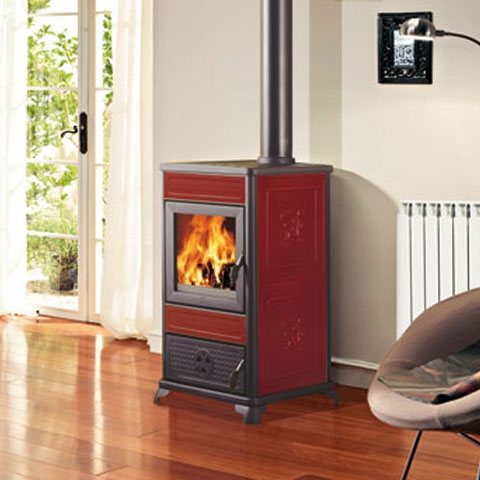
For maximum purity of the experiment, it is recommended to carry out it in cloudy windy weather. In the house, they turn off all household appliances, they do not cook, best of all, they completely free him. To organize a single interior space, all interior doors are opened. After a day, temperature measurements are taken at different points in the house. The data obtained are averaged.
If the house is small, then it is enough to turn on a 1 kW heater. If there are many rooms, they include several low-power heaters. A day later, the temperature is measured again at different points of the structure, and the average value is found. Next, the difference between the temperature in the house with and without heaters is determined and divided by the total power of the heating devices used. Thus, the number of degrees is determined by which the air in the house is heated at a cost of 1 kW of power. Let's say it's 10 °.
The experiment can be carried out at any time of the year, since this practically does not affect the measurement result. The main conditions are the presence of wind, since it is in windy weather that the maximum heat loss occurs, which distorts the result.
The main characteristics of the sauna stoves
To choose a sauna stove, you need to decide on several characteristics and their combination:
- heating method (type of fuel);
- maximum heating power;
- dynamic range - the ability to adjust the heat output;
- thermal inertia, the ability to stabilize the temperature in a steam room;
- heat transfer rate, surface temperature;
- dimensions;
- vaporization;
- the ability to use heat to heat water.
The stove can be made of metal or made of stone. At the same time, modern metal stoves are a winning option, since they are compact in size and allow you to heat the steam room in a short time.
Features of the design of stone furnaces
Convenience, functionality, aesthetics, but most importantly, safety - these are the characteristics that heating devices in living quarters should have. Stone oven masonry - a responsible and difficult business, requiring special skills and experience, but no less important is a competent project of the future object. It is more expedient and easiest to provide for the presence of a stove at the design stage of the house. This will allow during the construction process to lay the chimney system in the walls, saving the usable area of the premises and ensuring their maximum heating in the future.
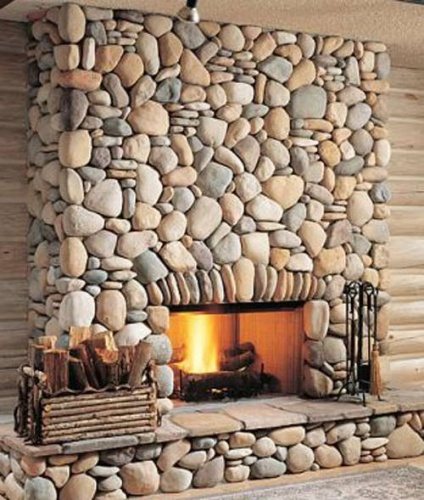

Flue ducts have a different structure:
- direct-flow or counter-flow;
- with vertical or horizontal channels;
- one revolving or multi-revolving;
- channelless;
- with a lower heating system.
The chimney system is planned depending on the type of oven.
A well-planned stone oven will be as functional and easy to maintain as possible. It will harmoniously fit into the interior, and will not clutter up the living space. For example, the double-sided combined version of the "stove-fireplace" looks very interesting, when part of the stove with a hob is placed in the kitchen, and a fireplace is installed in the room. In this case, a common chimney system is used.
Power selection
In terms of power, the sauna stove is chosen so that it can maintain a high temperature in the steam room. For a Russian bath or hammam, you need to warm up the room to 40-600C. For a sauna - up to 80-1100C. It is clear that the higher the required temperature and the larger the volume of the room, the more power is required.
The choice of power is influenced by:
- steam room temperature;
- thermal insulation qualities of walls and outside temperature;
- steam generation requirements;
- steam room volume.
An accurate calculation of the optimal power requires the calculation of the thermal resistance of all enclosing structures, taking into account their location and external temperature. But there is also an easier way to do without complex heat engineering calculations.
To determine the required power, you can focus on the average estimate - 1 kW per 1 m3 of steam room volume. Take, for example, a room with dimensions of 2x3 m and a height of 2 m. The calculation of the volume is simple - it is obtained by multiplying all three dimensions. In our case, the volume of the steam room is 12 m3. 12 kW - this will be the "ideal" design power. If part of the enclosing structures of the steam room does not have thermal insulation, for example, a door, then its area must be multiplied by 1.2 and added to the value obtained earlier. For example, if the door has dimensions of 2x0.7 m, then the additive will be 1.68 kW. We round up and as a result we get the required power of 14 kW.
If the door is made of glass, then to calculate the correction for non-insulated structures, its area is multiplied by 1.5. The same amendment is introduced for the window, if any.
The resulting value is a guideline for choosing a suitable oven. It is better if the real power is slightly higher than the calculated one, but not too much. The high maximum power allows you to quickly warm up the steam room, but then the heating must be reduced in accordance with the operating thermal regime. If the power cannot be reduced to the required level, the steam room will not be able to obtain the desired atmosphere.
Types of stoves for a bath
Currently, there are three types of sauna stoves on the market:
- solid fuel;
- gas;
- electrical;
You can also use liquid fuel - fuel oil or diesel fuel, but this solution is rarely used.
- The wood-fired sauna stove is characterized by high power and simple design. Wood-fired stoves can be great for heating large steam rooms, but adjusting their power is not easy.They are not adapted to work with automatics, and a large mass of stones is used to stabilize the temperature. The combination of an iron furnace and stones, which are placed in special containers or a mesh casing, gives the required power and heating stability.
- In terms of use, the most convenient ovens are electric. They have a wide range of heating settings and are able to stably maintain not only the power level, but also the temperature. For this, they are equipped with a power regulator and a thermostat. Ease of use and automatic temperature maintenance are the main advantages of the electric heater.
Electric heaters have low thermal inertia. To increase it, their design provides for the possibility of stacking stones above the heater. The stones with their heat capacity equalize the heating differences associated with the operation of the thermostat. In addition, the heated stones evaporate the water, which gives the desired steam.
The only drawback of electric ovens is the power limitation due to connectivity. Even 5 kW require special wiring, and 10-15 kW are often unavailable.
- The use of a gas sauna stove removes the power limitation and allows the heating to be regulated within a wide range. Stability of work is also the strong point of such units. Electric and gas heaters do not require a large volume of stones, as they can maintain a stable operation of the heater or burner.
Stone stove for sauna and home
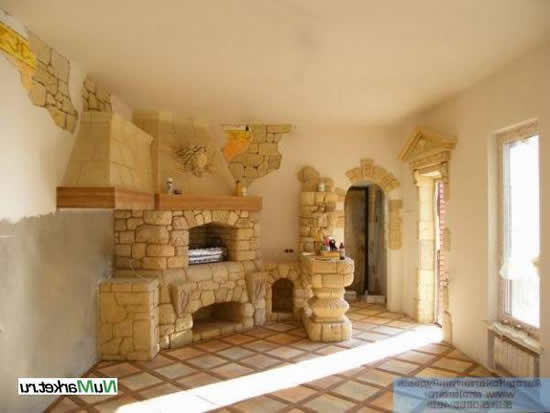

Despite the abundance of modern heating equipment, stone stoves have not lost their relevance to this day. Firstly, it is a reliable and functional source of heat in country houses and dachas located in areas where there is no centralized gas heating. Secondly, alternative fuels (wood, coal) are significantly less expensive than gas or electricity. Thirdly, the heat from the stone stove creates a special atmosphere of coziness and comfort, and the food cooked on the stove has a unique taste and aroma. In addition, modern design projects of stone stoves make it possible to turn a prosaic household device into a real highlight of any interior.
Furnace types


Devices for home heating and cooking were invented by people many centuries ago. Cultural traditions, cuisine and climatic features of the place of residence of this or that nation played a direct role in the evolution of these adaptations, as evidenced by the different types of stoves that exist today.
Stone stoves for houses and dachas, which are most popular today among Russian owners of suburban property, differ in their design and their names, which speak of the place of origin of a particular model, for example, a Russian, Dutch, Swedish stove, etc.
In addition, the furnaces are divided according to their functional purpose into:
- heating,
- cooking,
- combined (heating and cooking).
Heating stoves
The main and only function of these stoves is to heat the room. They are not intended for cooking or even heating food. These designs are called Dutch ovens. Their overall dimensions are determined by the area of the heated room. They have a compact rectangular shape and are installed in living rooms or bedrooms.
Cooking ovens
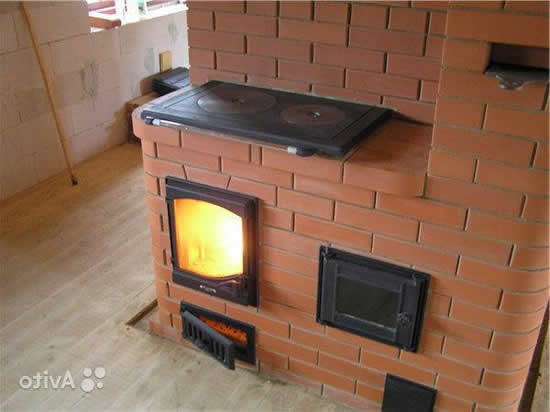

A stone cooking stove is mainly used for cooking and heating a small room. Summer cottages are most often equipped with this type of stove, because serious heating of a large house does not allow for their design features. Such ovens have a hob and often an oven.
Combined ovens


This type of oven is also called "Swedes". This is the most versatile and most convenient option.The device of a stone oven of a combined type assumes the possibility of heating a large area of the room and conditions for cooking. Usually they are installed in the interior wall in such a way that the hob is located in the kitchen, and the main part goes into the residential part of the house. Often, such structures are equipped with a stove bench, turning them into a real Russian stove.
Special purpose ovens
Separate categories include stone sauna stoves and garden stoves used for outdoor cooking.
Sauna stoves
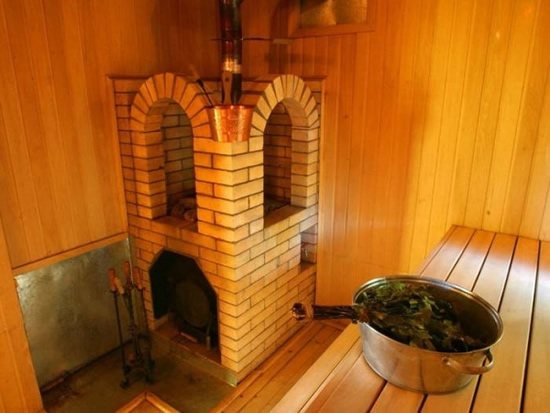

Stone sauna stoves have one purpose - high-quality heating of the sauna room. True fans of sauna relaxation prefer wood-fired stoves, believing that only these structures are capable of creating a unique therapeutic microclimate in the steam room.
According to the principle of operation, these units are divided into two types:
- Batch stoves with a closed heater. In this version, the stones are located in the chimney. You can use such a stove only a few hours after kindling, only after the final combustion of the fuel.
- Sauna stoves of continuous operation with an open heater. The stone bowl is open in them, so constant replenishment of the fire is required. Before starting the bath procedures, the heater is heated for about 2.5 hours, and then this process is maintained during the steam session.
Important! One of the main requirements for sauna stoves is safety, and in this regard, the option with an open stove is safer, because such a design eliminates the risk of carbon monoxide entering the steam room, while in the first case such a danger exists.
Garden ovens
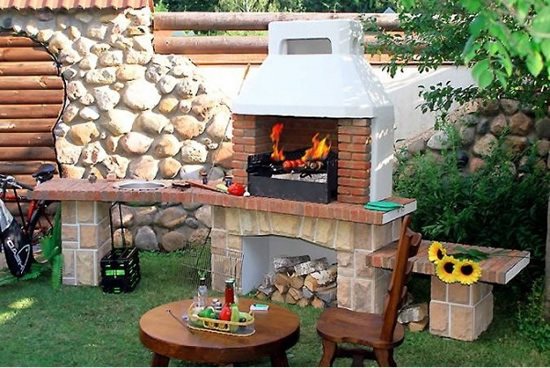

Garden ovens are designed for outdoor cooking on charcoal or fire. They have a rather simple design, which includes a brazier firebox and a storage for firewood, and in more complex models, a chimney is also provided.
Stone barbecue ovens with an open hearth are considered the most convenient for cooking meat and fish kebabs, steaks, poultry dishes, etc.
The most serious functionally are garden ovens with an oven. In such models, you can bake bakery products, cook porridge and even first courses.
Choosing the optimal stone oven model
In addition to certain operational parameters of stone furnaces, the choice of a particular model should also be based on the characteristics of the structure itself (purpose, layout features, dimensions, fire safety, etc.). With proper consideration of all these criteria, one stone stove for a summer residence or a house will warm up all rooms with high quality and evenly.
To ensure maximum heating capacity, the stove must be planned in such a way that all of its heat-dissipating surfaces are located in proportion to the area and heat loss of each room.
The shape of the oven is:
- rectangular,
- square,
- round,
- T-shaped,
- angular.
Features of the design of stone furnaces
Convenience, functionality, aesthetics, but most importantly, safety - these are the characteristics that heating devices in living quarters should have. Stone oven masonry - a responsible and difficult business, requiring special skills and experience, but no less important is a competent project of the future object. It is more expedient and easiest to provide for the presence of a stove at the design stage of the house. This will allow during the construction process to lay the chimney system in the walls, saving the usable area of the premises and ensuring their maximum heating in the future.


Chimney ducts have a different structure:
- direct-flow or counter-flow;
- with vertical or horizontal channels;
- single-turn or multi-turn;
- channelless;
- with a lower heating system.
The chimney system is planned depending on the type of oven.
A well-planned stone oven will be as functional and easy to maintain as possible. It will harmoniously fit into the interior, and will not clutter up the living space. For example, the double-sided combined version of the "stove-fireplace" looks very interesting, when part of the stove with a hob is placed in the kitchen, and a fireplace is installed in the room. In this case, a common chimney system is used.
Technologies and basic materials
The operational characteristics of stone kilns are determined by the quality and the correct choice of materials, adherence to technological requirements and the quality of the masonry.
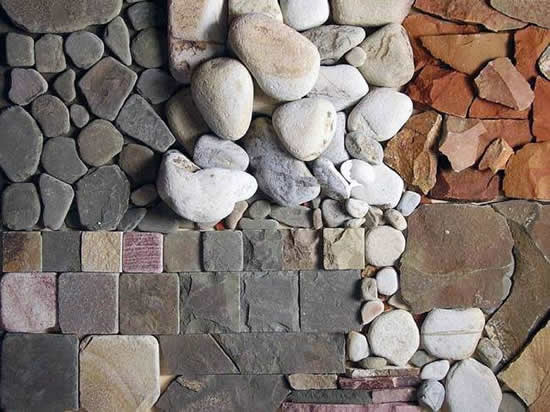

For the laying of stoves, natural stone materials (rubble stone, sandstone and limestone) or special heat-resistant types of bricks are used. To ensure even dense masonry and reliable adhesion to the mortar, bedded (flat) stones and rubble slabs are used.
The main material for the construction of stone kilns is red brick, made from clay, free of impurities, by plastic or dry pressing, followed by drying and firing. Fireclay bricks can withstand the highest temperatures (up to 1600 ° C).
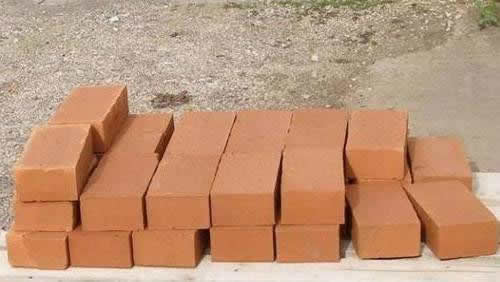

Furnace masonry technology provides for the use of several types of bricks with different levels of heat resistance. To ensure high-quality masonry, the brick must have the same rectangular shape, straight edges and corners, clear edges and smooth front surfaces.
Important! Masonry of stoves and chimneys is prohibited from silicate, hollow and perforated bricks.
Ordinary or red clay is used as the main ingredient in ordinary red brick oven mortar. Refractory clays (for example, Gzhel) are used when laying the walls of a firebox and fire channels made of refractory bricks.
Fine-grained sand acts as an aggregate in clay masonry mortar. This material should not be contaminated with various impurities and plant residues. Sand is added to red and refractory clays, and fireclay is used with refractory clays.
Lime and cement mortars are used for the construction of furnace foundations and pipe heads located above the roof.
Basic fire safety requirements for laying stoves


- the obligatory presence of cuts in the places of contact of chimneys and ventilation ducts with floor materials;
- it is forbidden to lay flooring close to the smoke ducts and the walls of the root pipe located in the walls;
- the obligatory presence of space between the wooden wall and the root pipes and stoves;
- the thickness of the upper stove floor must be at least three brick rows;
- coincidence of vertical seams during laying is not allowed;
- in the process of cutting, it is necessary to provide for the possible settlement of the building;
- mandatory presence of a steel sheet on the floor under the fire door.
Furnace design
The choice of a stove for a bath involves the selection of the most suitable design, and there are much more options here than when determining the required power.
Material
Most of the newly built baths are not intended for a large number of people, and their steam rooms have a small area. In such a steam room, the large dimensions of the stove become a hindrance. Therefore, a compact metal oven is a rational choice.
Another advantage of such a furnace is its ease of installation. It does not need a massive foundation, complex work. It is simply placed on a solid platform and connected to the chimney and to the water supply system, if it has a water heater.
Metal furnaces are manufactured from sheet steel. The sheets of the greatest thickness, up to 5 mm, are used for the manufacture of the firebox. The outer casing is painted with high-temperature paint, and in some models stainless steel containing 17% chromium is used as the material for the manufacture.
Heating stability
Steel conducts heat much better than brick, and therefore a metal stove has a high heat transfer. Such stoves heat up quickly and cool down faster than, for example, cast iron stoves, which reduces the risk of fire hazard situations. To accumulate heat and stabilize heating, stone backfill is used. The greater the mass of stones heated from the furnace, the less the intensity of heat transfer changes with temperature differences.
A large supply of heat allows for a large amount of steam. At the same time, its high quality is consistently ensured, since the temperature of the stones when sprinkled with water changes little due to their large mass.
Most of these stoves can be fired from a room adjacent to the steam room. The firebox door is located at a considerable distance from the body and is connected to the furnace by a neck - a fuel channel. Thus, it is possible to keep the steam room clean - all waste from the fuel remains in the dressing room.
Security
The furnace metal is heated to a high temperature, which can be dangerous for people. To avoid burns, this heater is equipped with a protective cover, like this model. In some cases, not a casing, but a stone backfill acts as a protective fence, as in grid furnaces, for example, the Siberian Cliff.
An air gap remains between the firebox and the protective casing, which serves as a heat insulator, which reduces the temperature of the outer casing. In this gap, a natural draft arises, which can be used to intensively distribute hot air throughout the entire volume of the steam room. To do this, holes are made in the case for air inlet from below and for outlet - from above, as in the models of the Kuzbass series.
The through flow of air through the air gaps of the casing enhances convection, which allows you to very quickly warm up the air in the steam room, and the backfill of stones stabilizes the heating and provides a supply of energy for vaporization. Often a steam generation device is built into the backfill. Using such a furnace design, it is easy to obtain a constant flow of steam.
Brick ovens
It is worth noting that the technology of building brick heating stoves is very complex. Therefore, it is better to entrust the construction to a professional stove-maker.
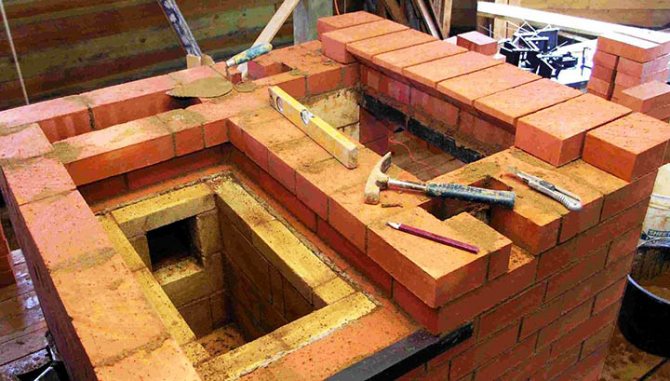

Installing a brick oven in a country house is a smart decision. Such ovens perfectly retain heat for a long time (which cannot be said about the metal varieties). This pattern can stay warm overnight. If, during its construction, solid bricks for stoves, as well as tiles, were used, you can enjoy the heat for several days.
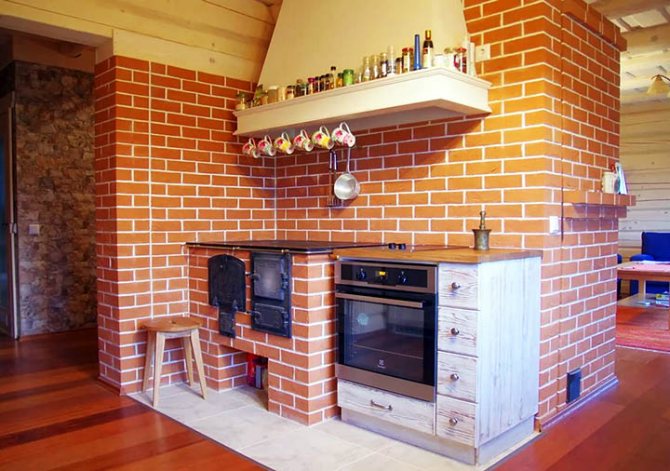

However, a brick oven has some disadvantages. Its construction is rather massive and complex. Therefore, in a small country house, such a model will be inappropriate. In addition, the cost of a brick oven is much higher than the cost of a metal product (this is influenced by the design features of the device).
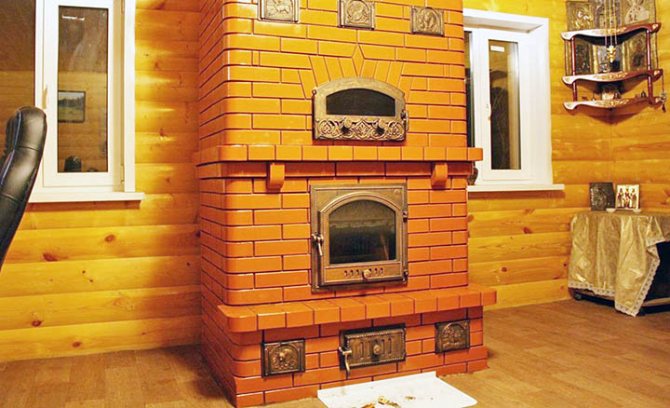

The main advantages of such ovens are as follows:
- Ease of use and maintenance;
- Local materials can be used during construction;
- Relatively high level of efficiency (COP);
- Possibilities of regulation of the combustion process;
- Durability and economy.
Hardwood can be used as fuel for a brick kiln, which ensures an even and continuous burning. For this purpose, it is better to use birch firewood (after combustion, they practically do not emit carbon monoxide).


In order for a brick stove for heating a country house to serve you for a long time, do not heat it with wet wood, and also do not burn cardboard or garbage in it. Do not heat the stove using flammable substances (such as gasoline). Otherwise, the likelihood of fire increases and the state of the environment suffers.
Stove stones
When choosing a stove for a bath, you need to take into account the mass of stones in the bookmark and the conditions for their heating. To obtain "light" steam, a high temperature is required.The stones should be heated to at least 150 ° C, and for a Russian bath - at least to 200-250 ° C. In this case, you can expect a good result.
Depending on the design, stones can be laid on top of the firebox or warmed up from all sides. In the latter version, the internal stone filling will serve as an excellent steam generator. It is very important that the stones do not cool down when in contact with water, so that they have a sufficient supply of energy and a strong flow of heat from the firebox.
How many stones do you need?
In order for the stones of the sauna stove to cope with their functions, they must have not only a high temperature, but also a sufficiently large mass.
For a small steam room equipped with an electric furnace, if intensive steam generation is not required, 3-5 kg of stones are enough. They are mainly needed only to smooth out fluctuations in heat transfer when turning on and off a thermostatically controlled heater.
If good steam is needed, then the weight of the backfill should be increased. In a small amount, the stones will quickly cool down and stop evaporating water well. If water droplets boil on stones, then they are already cold. Normally heated stones evaporate water almost instantly.
For a solid fuel stove, the mode of which is difficult to maintain constant, you need at least 5 kg of stones for each cubic meter of the steam room. And for a Russian bath, it is better to increase this amount to 8 kg. That is, for the steam room, given as an example at the beginning of the article, the mass of the stones to be laid will be 90 kg or so.
Which stones to choose?
For the bath, stones that are not too small are selected, at least 40 mm in size. Better - from 70 to 150 mm. For heat storage, size is not important, only weight is important. But the coarse fraction is more easily blown with air, and therefore it gives off heat better in ventilated backfills and warms up better in batch furnaces.
It is important that they withstand temperature fluctuations. If a red-hot stone, when poured with water, begins to crack with the scattering of fragments, it is not suitable for a steam room. Some types of rock, when heated, emit harmful substances.
Recommended breeds for the heater:
- gabbro-diabase,
- talcochlorite,
- jade,
- quartzite,
- quartz,
- porphyrite,
- basalt,
- river pebbles.
The last option on this list is affordable stones, which are easy to find in most regions. Basalt and gabbro-diabase are distinguished by their high heat capacity and resistance to strong heating. Talcochlorite is relatively light and has good thermal conductivity. Raspberry quartzite or jadeite can serve as a decoration for a steam room, as well as white quartz, which is called "hot ice".
Choice for a country house
Currently, heating appliances stores offer a wide range of products, which are usually installed in country-type houses. Each model will be effective in its own way if its choice is made taking into account the technical characteristics and operating conditions.
Depending on the individual requirements of homeowners, products have a number of specific differences, for example, a fireplace stove can be:
- rectangular;
- round;
- triangular;
- square;
- in the shape of the letter "T".
There are also original combined ovens. Such structures are characterized by the fact that they have a heating function in combination with the possibility of cooking on their surface, and this is very convenient for small country houses.
The bottom line is the realized possibility of switching modes, that is, the design can simultaneously perform both options, or work with them separately. This combination is really the best, because in the warm season there is an opportunity to save fuel.
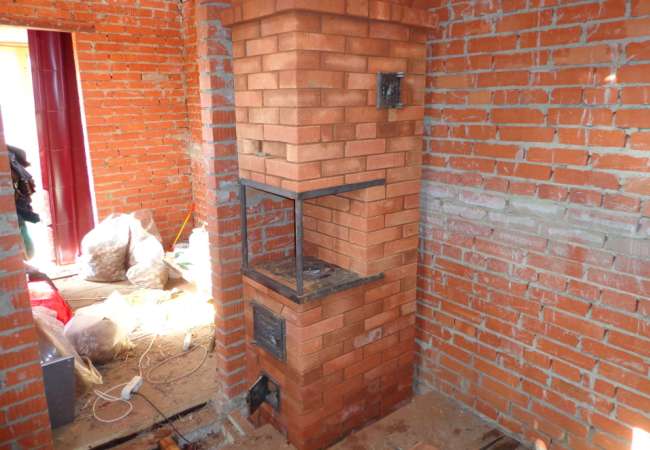

Erection of a furnace at the stage of building a house
Speaking about which stove is better in each specific case, first of all, you need to pay attention to the area that you plan to heat. Perhaps one or two rooms are to be heated, and the rest will not be used. In this case, you will have to be puzzled by drawing up a plan for a country house, which will describe how the heating system works.
Good to know: How to make a brazier under a cauldron from car disks
So, in order to answer the question: how to choose a stove for a summer residence based on the area, a certain calculation should be performed. On average, within 60 minutes, 1 m3 of the room loses about 60 Kcal of heat. At the same time, 1 m2 of the furnace gives off 500 Kcal of heat for the same time. Based on this, the conclusion suggests itself that to heat a house of 35 squares, a stove of only 1 m2 of area will be required.
Often, a dacha building is used in the summer, when the topic of heating is not relevant. However, during the operation of housing and in the cold season, it is necessary to make sure that the rooms warm up as soon as possible, keep warm for a long time and consume little fuel.
In this case, brick ovens will not cope with the task at hand, so it is better to spend a little more finance and purchase a ready-made cast iron structure, where there is a long burning system.
findings
So, what kind of stove to choose for a bath? This issue is resolved in a few steps.
- Determine the required capacity by the volume of the steam room and its thermal insulation. Study information about different models: the characteristics may indicate not the power, but the recommended volume of the steam room.
- Determine the maximum permissible dimensions of the furnace, taking into account the size of the steam room, its layout and ease of use.
- Specify the amount of space for laying stones. Here you should use the recommendations for calculating the required backfill weight and choose a model that can accommodate no less.
With all the variety of options for sauna stoves, you can make the right choice if you focus on these recommendations. If you still have doubts, you can always contact the qualified managers of the Teplodar online store.
mediagallery.teplodar.ru
Calculation of stones for a bath
Different sources recommend a different amount of stones per 1 m3 of a steam room with 15 people soaring at the same time for 5 hours. Let's take at a minimum: 30kg. Therefore, for our example, you need 30kg * 24.85m3 = 745.5kg.If the steam room is calculated not for 15, but for 5 people, then, accordingly, you need to reduce the volume of stones by 3 times: 745.5 kg / 3 = 248.5 kg ... Something too much for a 25 kW stove and weighing no more than 200 kg (cast iron) .... And what size should a metal stove be to fit so many stones? In another "ancient" book, it is recommended for every 6 liters of supplied water - 8 kg of cobblestone and 1.5 kg - for 1 m3 of steam room volume. In an hour, 5 people pour no more than 4 liters of hot water onto the stones, so during 5 hours of continuous vaping, they will spend at least 20 liters (which is unlikely). Still, let's reduce the amount of water by 30%, taking into account the pauses for airing and rest. It turns out that we need only 18.7 kg. We will also calculate the number of stones for the bath, taking into account the volume of the steam room: 1.5 kg * 24.85 m3 = 37.5 kg. We add everything up and get: 37.5 kg + 18.7 kg = 53.2 kg of cobblestone. This is already an acceptable figure for an ordinary simple bath. You can make a more complex calculation of stones for a bath, determining the required amount of heat by evaporation and heating ... But .., the task of this article is to determine the required power of the stove for the bath. Therefore, let's estimate how many kW is needed to heat 53.2 kg of stones for 15 minutes (the approximate time allotted for a pause between soaring) to a temperature of 500 degrees:
- 1 kg of stones from a temperature of 500 degrees, cooling down to 200 degrees (a difference of 350 degrees), will give 294 kJ (0.84 kJ / kg * C x 1 kg x 350 C).
- 53.2 kg will give 294 kJ * 53.2 kg = 15640.8 kJ. How much heat will be given off during cooling, the same amount needs to be replenished.
- 1 kW = 3600 kJ / hour
- we convert kJ to kW, we get 4.35 kW per hour
- we recalculate for 15 minutes: 4.35 * 4 = 17.40 kW
Conclusion: a furnace power of 20 kW will provide heating up to 500 degrees 53.2 kg of stones every 15 minutes. Let's add another 5 kW to the calculation of the power of the bath furnace to take into account heat losses through structures and cold surfaces. So, for a steam room with dimensions of 3x2x2.2m, a 25kW oven is needed, based on two different calculations:
- by the volume of the steam room and cold surfaces
- by the number of stones
With a lower consumption of the supplied water, for example, when soaring not five people, but two, for not five hours, but only a couple of three, you can choose a stove with a lower power (20 kW).
banjstroi.ru
